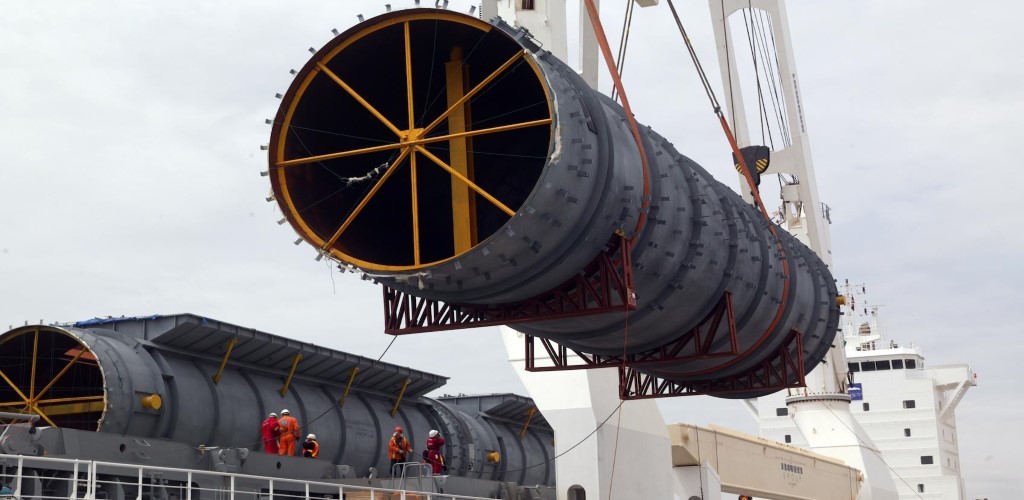Sep 21 | 2021
Future-looking mindset vital

Enhanced data integration, real-time visibility and remote inspections will become increasingly vital for breakbulk supply chains over the next two year as firms grapple with volatility in a post-pandemic world, Agustín Harriague, Head of Logistics US at Siemens Energy tells Breakbulk.
With cargo carriers in the U.S. facing unprecedented congestion and sharp spikes in costs, the outlook for businesses over the next 24 months is uncertain, as many teams scarcely have time to respond to current demand, never mind forecast into the future, but this pressure may ultimately reshape working practices across the supply chain.
“We need to take a few lessons out of the current crisis. The way we all used to work and the way we do things will most likely not be fit for the future,” Harriague says. “We have projects that have to deliver with a tight schedule, that are heavily affected by the current situation. At this point it is difficult for anyone to predict when this is going to stabilize, as natural disasters and events with global impact unfold and merge with new COVID-19 outbreaks.”
Future-looking mindset
Digitalization of the project logistics chain has long been an agenda item for breakbulk carriers but this trend has been super-charged over the last six months as access to the latest data proves crucial in meeting deadlines in the current climate.
“Getting systems to integrate smoothly to give you supply chain transparency is hard, but if you don’t do that, you can’t see what’s happening,” Chris Nicholson, CEO of analytics developer Pathmind, notes. “And, if you can’t see what’s happening in your supply chain, you’re never going to control it.”
The race to digitize processes however is happening at the same time as the race to find capacity, or squeeze additional capacity out of existing assets, and for many firms this adds a further layer of confusion as competing platforms jostle for attention and many staff lack the training to discern the truly useful from the latest fad. Training staff to understand the data and handle the various new platforms that are emerging is therefore expected to be a key requirement for firms over the next two years.
“Development of our people is one of the key investments in project logistics needed over the next 24 months," Harriague explains."[digitization] will have to combine with developing new skills for our people, giving them the tools and fostering a future-looking mindset that is open to different ways to ship our project cargoes, see around corners and mitigate risks in a very volatile environment."
The ability to get granular insight of delays and understand future risk is of course an ever-present problem for project cargo operators but with the onset of record congestion in U.S. ports this issue has risen to new levels.
“The main bottlenecks for breakbulk cargo are both the availability of space and the reliability of transit times and schedules. The record-breaking prices we see in the market are a consequence of this so from my point of view capacity is right now the major challenge,” Harriague notes.
Geopolitical risk
Alongside the data challenges invoked by runaway volatility in charter rates and widespread congestion around the world, the ongoing trade tensions between China and the U.S. continue to pose challenges for operators seeking to integrate their supply chains.
Harriague predicts: “We will need to closely monitor geopolitics and the way those translate into trade policy. Over recent years our supply chains have been at greater risk due to trade policies, Brexit, trade wars, etc. Total cost of ownership has to come to the forefront of our decisions, including those risks associated with our global supply chains.”
While cross-border transit has always required shipping lines to navigate multiple regulatory jurisdictions and keep an eye out for upcoming legislation, the new reality of lockdowns and trade was is increasingly meaning that logistics firm must become political analysts as well.
“The current situation has not only posed a risk to operations, but to our abilities to budget logistics cost for future projects. Putting together transport cost for projects that will execute 1-2 years from now it is certainly a difficult task these days,” Harriague said.
North American growth
Despite these challenges, Harriague foresees strong upside for the project cargo sector in North America as economic recovery progresses and the White House doubles down on infrastructure investment programs across the U.S.
“My team is responsible for the Americas region within the Power Generation Division and there is a strong potential for projects in Canada as well as in the U.S. where bipartisan support for the infrastructure framework will be key to back projects in the pipeline and bring new opportunities,” Harriague said
Outside of the U.S. the energy sector in Latin America is also forecast to hold potential upside as new technologies emerge to displace older polluting power generation plants, and decentralized generation emerges as a growing trend in many areas that have so far been bypassed by industrialization.
Subscribe to BreakbulkONE and receive more industry stories and updates around impact of COVID-19.
